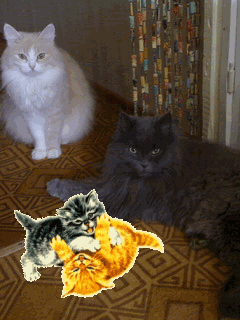"I want a feminist writing of the body that metaphorically emphasizes vision again, because we need to reclaim that sense to find our way through all the visualizing tricks and powers of modern sciences and technologies that have transformed the objectivity debates. We need to learn in our bodies, endowed with primate color and stereoscopic vision, how to attach the objective to our theoretical and political scanners in order to name where we are and are not, in dimensions of mental and physical space we hardly know how to name."
[Donna Haraway, “The Persistence of Vision,” in The Visual Culture Reader, Nicholas Mirzoeff, ed., (London: Routledge, 1992) p.678]
"It is in that languidly unreeling pulsation, that hypnotically erotic, visual throb of Duchamp’s Precision Optics, that one encounters the body of physiological optics’ seeing fully enmeshed in the temporal dimension of nervous life, as it is also fully awash in optical illusion’s ‘false induction.’ But it is here, as well, that one connects to this body as the site of libidinal pressure on the visual organ, so that the pulse of desire is simultaneously felt as the beat of repression." [Rosalind Krauss, The Optical Unconscious (Cambridge, MASS & London: The MIT Press, 1998, c.1993) p.138]
"The cerebral cortex is not above the body in an ideal or ideated remove; it is, instead, of the body, such that the reflex arc of which it is a part connects it to a whole field of stimuli between which it cannot distinguish." [Rosalind Krauss, ibid., p.124]
"The nervous system is not contained within the body’s limits. The circuit from sense-perception to motor response begins and ends in the world. The brain is thus not an isolable anatomical body, but part of a system that passes through the person and her or his (culturally specific, historically transient) environment. As the source of stimuli and the arena for motor response, the external world must be included to complete the sensory circuit." [Susan Buck-Morss, "Aesthetics and Anaesthetics: Walter Benjamin's Artwork Essay Reconsidered," in October, no. 62 (Fall 1992) p.12]
Note: you can blame L.M. for this post because A: she introduced me to Trippy Text and B: she said I should use it to write my dissertation.
Oh yeah! Thanks. This dissertation will have to be a team effort. - sally mckay 5-06-2010 2:00 pm
Thanks to Candice for this one.
- sally mckay 5-06-2010 2:01 pm
The Haraway quote might have been helpful in the Sillman "debate" (angry painters pile on Tom), with the conclusion that Sillman's "tactility" and dopy old light bulb are a retreat from responsibility to understand "the visualizing tricks and powers of modern sciences and technologies."
As for primate color, is Haraway joking/punning? - tom moody 5-06-2010 10:10 pm
I'd guess she's punning but not joking. Haraway is pretty interested in humans-as-animals and how we co-evolve with other species. - sally mckay 5-06-2010 10:46 pm
"I want a feminist writing of the body that metaphorically emphasizes vision again, because we need to reclaim that sense to find our way through all the visualizing tricks and powers of modern sciences and technologies that have transformed the objectivity debates. We need to learn in our bodies, endowed with primate color and stereoscopic vision, how to attach the objective to our theoretical and political scanners in order to name where we are and are not, in dimensions of mental and physical space we hardly know how to name." [Donna Haraway, “The Persistence of Vision,” in The Visual Culture Reader, Nicholas Mirzoeff, ed., (London: Routledge, 1992) p.678]
"It is in that languidly unreeling pulsation, that hypnotically erotic, visual throb of Duchamp’s Precision Optics, that one encounters the body of physiological optics’ seeing fully enmeshed in the temporal dimension of nervous life, as it is also fully awash in optical illusion’s ‘false induction.’ But it is here, as well, that one connects to this body as the site of libidinal pressure on the visual organ, so that the pulse of desire is simultaneously felt as the beat of repression." [Rosalind Krauss, The Optical Unconscious (Cambridge, MASS & London: The MIT Press, 1998, c.1993) p.138]
"The cerebral cortex is not above the body in an ideal or ideated remove; it is, instead, of the body, such that the reflex arc of which it is a part connects it to a whole field of stimuli between which it cannot distinguish." [Rosalind Krauss, ibid., p.124]
"The nervous system is not contained within the body’s limits. The circuit from sense-perception to motor response begins and ends in the world. The brain is thus not an isolable anatomical body, but part of a system that passes through the person and her or his (culturally specific, historically transient) environment. As the source of stimuli and the arena for motor response, the external world must be included to complete the sensory circuit." [Susan Buck-Morss, "Aesthetics and Anaesthetics: Walter Benjamin's Artwork Essay Reconsidered," in October, no. 62 (Fall 1992) p.12]
Note: you can blame L.M. for this post because A: she introduced me to Trippy Text
and B: she said I should use it to write my dissertation.
- sally mckay 5-06-2010 1:39 pm
Where are the kittens?

- L.M. 5-06-2010 1:54 pm
Oh yeah! Thanks. This dissertation will have to be a team effort.
- sally mckay 5-06-2010 2:00 pm
Thanks to Candice for this one.
- sally mckay 5-06-2010 2:01 pm
The Haraway quote might have been helpful in the Sillman "debate" (angry painters pile on Tom), with the conclusion that Sillman's "tactility" and dopy old light bulb are a retreat from responsibility to understand "the visualizing tricks and powers of modern sciences and technologies."
As for primate color, is Haraway joking/punning?
- tom moody 5-06-2010 10:10 pm
Tom is talking about this thread, and this thread from Art Fag City.
I'd guess she's punning but not joking. Haraway is pretty interested in humans-as-animals and how we co-evolve with other species.
- sally mckay 5-06-2010 10:46 pm